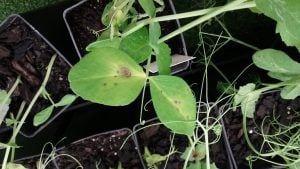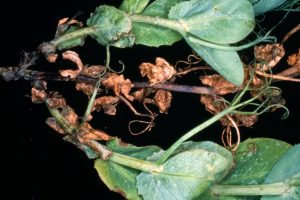Ascochyta blight (blackspot) is one of the most common and important foliar diseases affecting field pea. It is caused by four pathogens that occur as a complex in the field and cause a single disease where the symptoms caused by each pathogen are undistinguishable. They can all be found on a single diseased plant. However, the pathogens, Didymella pinodes (synonym: Mycosphaerella pinodes), Phoma medicaginis var. pinodella, Phoma koolunga and Didymella pisi are separable in laboratory and glasshouse studies. The disease is wide-spread in Victoria, South Australia and southern New South Wales. Field surveys have shown that Didymella pinodes predominates in Victoria. The severity of the disease varies greatly from crop to crop and between seasons. In wet seasons when conditions are conducive, yield losses up to 60 per cent have been reported within individual crops, but in a dry season, crop losses are much reduced.
What to Look For
The pathogen infects all above–ground parts of field pea plants as well as the upper root system below ground level. Early symptoms consist of circular necrotic spots that coalesce into large lesions on leaves, stems, and pods and a root rot may occur in severe cases. Early infection can cause seedling death.

Irregular shaped dark brown to black lesions or flecks on infected leaves and pods (Photo: Dr Pragya Kant – Agriculture Victoria)

Severe pod infection showing irregular extended lesions can cause grey-brown discolouration of the seeds.
Lesions are purplish-black in colour and cause streaking of the lower stem. Conspicuous spotting of the leaves and pods also occurs. The leaf spots may be either small, irregular, dark-brown and scattered over the leaf, or a few large, circular brown spots. Spots on the pods may combine to form large, sunken, purplish-blackish areas.
Infected seeds may be discoloured and appear purplish-brown. Discolouration is usually more pronounced on those areas of the seed coat next to diseased areas on the surface of the pod. Lightly infected seed may appear healthy.
Disease Cycle
The fungi that cause ascochyta blight may be seed borne, soil borne or survive in pea trash. The disease usually becomes established when sexual ascospores of the fungus (D. pinodella), produced in perithecia on old pea stubble, are carried into the new crop by rain and wind causing early infection. Asexual conidia are produced by other pathogens in pycnidia (fruiting bodies) and can infect pea plants at any stage of plant growth. Pycnidia and perithecia develop on infected plants throughout the growing season and after harvest on pea stubble and infected volunteer plants. Airborne ascospores are the main source of primary infection, whereas the secondary infection is caused by production of conidia. Discharge of both types of spores needs rainfall or dew, therefore epidemics are more severe in wetter conditions. Spores produced on infected foliage are transferred onto adjacent healthy plants by wind and rain splash.
The disease can also become established by sowing of infected seed and up to 90 per cent of the crop may be infected. The proportion of diseased seedlings arising from any infected seed lot is influenced by seasonal conditions such as high rainfall and soil factors. In a dry year, the planting of infected seed may not produce a diseased crop, but under wet conditions severe disease is likely.
Management
Ascochyta blight is best controlled by destroying infected pea trash and self-sown plants. The severity of disease may also be reduced by crop rotation, by the use of disease-free seed, resistant varieties, fungicidal seed dressing and foliar fungicides (in some situations).
Use Clean Seed
Seed should be tested for disease before sowing. Only use seed if less than 5 per cent is infected. Using old or damaged seed can reduce seedling vigour and increase susceptibility to infection.
Destroy Old Pea Crop Residues
Destroying pea stubble by grazing, burning and cultivation will reduce disease risk by minimising the number of spores available to infect new crops. Self-sown peas must also be controlled to prevent carry-over of the disease.
Paddock Selection
Avoid planting this season’s crop near old field pea stubble. Previous pea crop residues can harbour the ascochyta blight pathogens. Aim for a separation of at least 500 m from last year’s pea paddock.
Crop Rotation
The ascochyta blight fungi can survive in soil and on old pea trash; it is only safe to re-crop an area with peas after all pea debris has decomposed. Field pea should not be sown on land planted to pea the previous year nor on land adjacent to pea stubble. Where possible, field pea should not be grown in the same paddock more than once in three years. If disease occurs, the rotation should be extended to one in four or five years.
Sowing Dates
Follow the recommended sowing rates and sowing dates for your district. Avoid early sowing at high seeding rates as this increases exposure of pea seedlings to the ascochyta pathogens and produces crops with a large canopy, increased lodging and high humidity; all of which increase the risk of developing disease.
Ascochyta Spore Forecasting Model
Blackspot Manager is a forecasting model for ascochyta blight of field peas. It can be used by agronomists and growers to help identify the best sowing dates that minimize the risk of ascochyta blight without delaying sowing longer than necessary. It can also be used to determine the risk of ascochyta blight at the actual sowing date, so a disease management strategy can be tailored to the risk level. The sowing dates are developed for different rainfall regions after first autumn rains. Blackspot Manager is produced by the Department of Primary Industries and Regional Development (DPIRD) and predictions are made for field pea crops in New South Wales, South Australia, Victoria and Western Australia.
Forecasts are regularly updated on DPIRD Crop Disease Forecasts from April through June each year. The optimum agronomic sowing window for field peas in each of the districts is shown alongside the forecasts.
Chemical Control
Fungicidal seed dressings registered for use on ascochyta blight of field peas, when applied correctly, will control seed-borne disease and protect young plants from early infection. It is recommended that all pea seed be treated with a fungicide. Where seed is to be inoculated apply the fungicide first and allow to dry. Apply the inoculum immediately prior to sowing. Fungicides and inoculant should never be mixed together. If the potential yield is over 2t/ha, then use P-Pickel T and apply mancozeb (2kg/ha) at the 9 nodes stage and again at early flowering.




